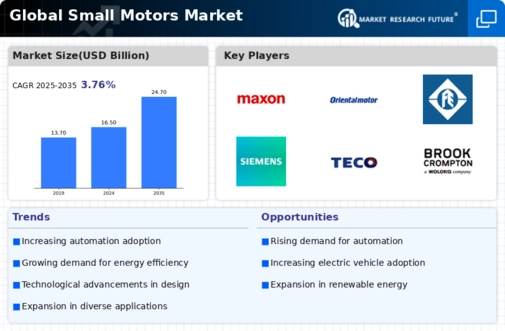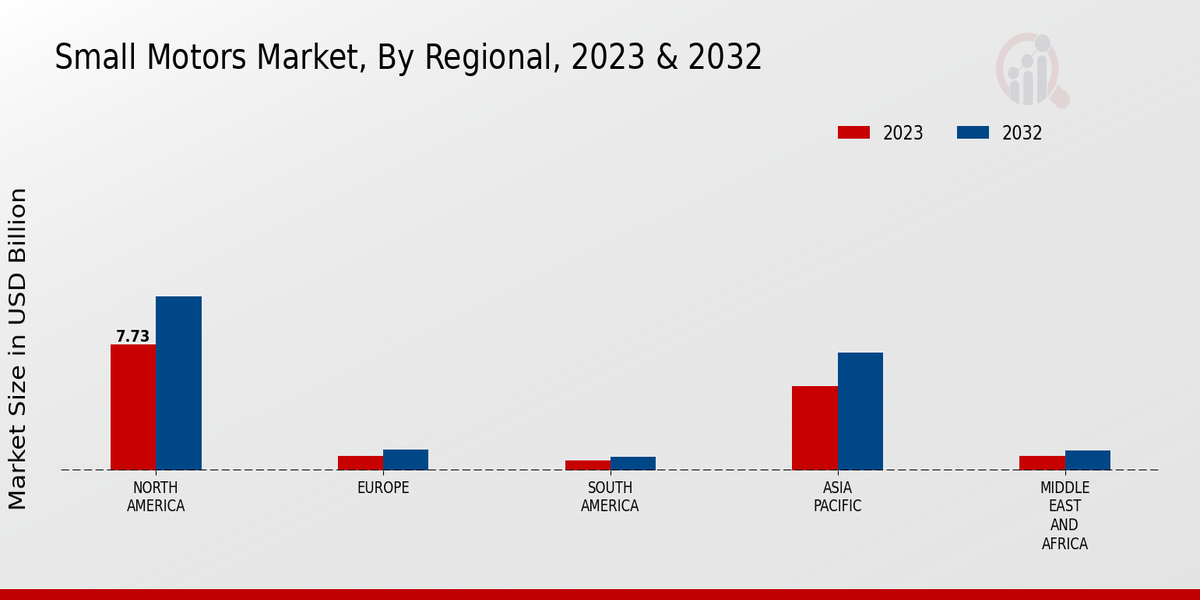Rising Demand for Automation
The Global Small Motors Market Industry experiences a notable surge in demand for automation across various sectors, including manufacturing, automotive, and consumer electronics. As industries increasingly adopt automated solutions to enhance efficiency and productivity, small motors play a pivotal role in driving these advancements. For instance, the integration of small motors in robotics and automated machinery is expected to contribute significantly to the market's growth. The market is projected to reach 16.5 USD Billion in 2024, reflecting the growing reliance on automated systems that utilize small motors for precise control and operation.
Market Trends and Projections
The Global Small Motors Market Industry is characterized by various trends and projections that indicate its future trajectory. The market is expected to grow from 16.5 USD Billion in 2024 to 24.7 USD Billion by 2035, reflecting a robust compound annual growth rate of 3.76% from 2025 to 2035. Key trends include the increasing adoption of automation, advancements in motor technology, and the rising demand for energy-efficient solutions across multiple sectors. These factors collectively shape the market landscape, presenting opportunities for manufacturers and stakeholders to capitalize on emerging trends and innovations.
Growth in Electric Vehicle Production
The Global Small Motors Market Industry is significantly influenced by the growth in electric vehicle production, which necessitates the use of small motors for various applications. Electric vehicles rely on small motors for functions such as power steering, window lifts, and HVAC systems. As governments worldwide implement stricter emissions regulations and promote electric mobility, the demand for electric vehicles is expected to rise. This trend is likely to bolster the small motors market, contributing to a compound annual growth rate of 3.76% from 2025 to 2035, as manufacturers adapt to the evolving automotive landscape.
Increasing Consumer Electronics Market
The Global Small Motors Market Industry benefits from the increasing consumer electronics market, where small motors are integral components in devices such as smartphones, home appliances, and personal care products. As consumer preferences shift towards smart and connected devices, the demand for small motors that enable automation and enhanced functionality is on the rise. This trend is expected to drive market growth, as manufacturers seek to innovate and incorporate advanced motor technologies into their products. The expansion of the consumer electronics sector is anticipated to further solidify the position of small motors within the global market.
Technological Advancements in Motor Design
Technological advancements in motor design are transforming the Global Small Motors Market Industry by enabling the development of more efficient and compact motors. Innovations such as brushless DC motors and advanced materials are enhancing performance while reducing energy consumption. These improvements not only cater to the increasing demand for energy-efficient solutions but also expand the application range of small motors in diverse industries. As a result, manufacturers are likely to invest in research and development to create next-generation motors that meet evolving market needs, thereby driving the market's projected growth to 24.7 USD Billion by 2035.
Focus on Energy Efficiency and Sustainability
The Global Small Motors Market Industry is witnessing a growing focus on energy efficiency and sustainability, prompting manufacturers to develop eco-friendly motor solutions. As industries and consumers alike prioritize reducing their carbon footprints, the demand for energy-efficient small motors is likely to increase. This shift is evident in various sectors, including HVAC, where energy-efficient motors are essential for compliance with environmental regulations. The emphasis on sustainability is expected to drive innovation in motor technologies, ultimately contributing to the market's growth as businesses strive to meet both regulatory requirements and consumer expectations.









